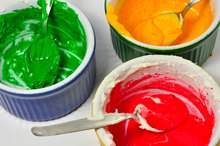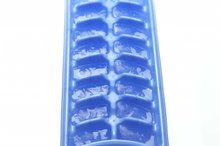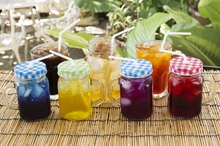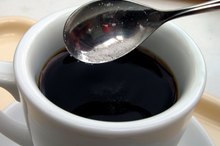The Disadvantages of Using Food Additives
Food additives serve a very useful purpose: They ensure that your food lasts longer and conserves its flavor, texture and color. Some additives even help maintain the original nutritional value of the food so that it doesn’t dissipate as the food gets older. As many benefits as food additives have, however, they also have a good number of disadvantages.
Can Cause Allergies
A number of additives can cause allergic reactions. The two most widely artificial colorings -- Red 40 and Yellow 5 -- are also the most likely additives to cause allergy-like reactions and hypersensitivity. They can also cause hyperactivity in some children. Red 40 and Yellow 5 are widely used in everything from pet food and sausages to soda, candy and pastries. Other food additives that are known to cause allergic reactions in some people include the artificial coloring carmine, tragacanth gum and sodium benzoate.
- A number of additives can cause allergic reactions.
- Other food additives that are known to cause allergic reactions in some people include the artificial coloring carmine, tragacanth gum and sodium benzoate.
Cancer Risk
Allergy to Red Dye in Drinks
Learn More
The position of the FDA is that none of the food additives on the market are dangerous 2. Small studies and organizations like the Center for Science in the Public Interest disagree 1. The most controversial additive is the artificial sweetener aspartame, used to sweeten diet soda, chewing gum and some desserts. In a few small studies, rats that consumed aspartame developed cancer. It’s likely that the amount of these additives present in foods is too small to cause any harm. However, it’s difficult to say what will happen in the long-term.
- The position of the FDA is that none of the food additives on the market are dangerous 2.
They Trick the Eye
Much of the enjoyment of food comes from the way it looks. The problem is that once you can freeze or process some of the foods, they lose their original color. To make the product more enticing, manufacturers sometimes add coloring. For example, Florida oranges sometimes have Citrus Red 2 artificial coloring added to make them look brighter. Many fruit drinks also make use of food colorings, as do some precooked meats, soy sauce and even beer. The bright colors might make you believe you’re eating something healthier, while in reality you might be drinking diluted juice that’s full of sugar. Always check labels to see the nutritional content of a product before you buy it.
- Much of the enjoyment of food comes from the way it looks.
- Many fruit drinks also make use of food colorings, as do some precooked meats, soy sauce and even beer.
They Replace Real Ingredients
The Side Effects of Artificial Food Coloring
Learn More
The flavor enhancer monosodium glutamate, or MSG, helps bring out the flavor of the foods it is used in. The problem with this is that manufacturers can reduce the amount of the real ingredient and still have the same strong flavor in the final product. So a can of chicken soup could contain very little chicken, and an orange juice cocktail might contain very little to no real oranges.
Related Articles
References
- Center for Science in the Public Interest: Food Additives
- Environment, Health and Safety Organization: Advantages of Food Additives
- U.S. Food & Drug Administration. Overview of food ingredients, additives & colors. Updated April 2010.
- Mondal, S. Food Safety and Human Health. Amsterdam, Netherlands: Elsevier Science; 2019.
- Food Allergy Research & Education. Blood tests. Updated 2019.
- Asthma and Allergy Foundation of America, New England Chapter. Adverse reactions to food additives. Updated 2019.
- Smolinske, SC. CRC Handbook of Food, Drug, and Cosmetic Excipients. Boca Raton, FL: CRC Press; 2018.
- Michigan New, University of Michigan. Food dye can cause severe allergic reactions. Updated January 25, 2007.
- Myles IA, Beakes D. An Allergy to Goldfish? Highlighting the labeling laws for food additives. World Allergy Organ J. 2009;2(12):314-316. doi:10.1097/WOX.0b013e3181c5be33
- Institute of Agriculture and Natural Resources, Food Allergy Research and Resource Program. Soy lecithin, soybeans and soy lecithin. Updated August 7, 2019.
- Saha D, Bhattacharya S. Hydrocolloids as thickening and gelling agents in food: a critical review. J Food Sci Technol. 2010;47(6):587-97. doi:10.1007/s13197-010-0162-6
- Sampson, HA, Simon, RA. Food Allergy: Adverse Reactions to Foods and Food Additives. Hoboken, NJ: Wiley; 2011.
- Institute of Agriculture and Natural Resources, Food Allergy Research and Resource Program. Spices and herbs. Updated March 10, 2014.
- Chen JL, Bahna SL. Spice allergy. Ann Allergy Asthma Immunol. 2011;107(3):191-265. doi:10.1016/j.anai.2011.06.020
- Adkinson Jr., NF, Bochner, BS, Burks, AW, Busse, WW, Holgate ST. Middleton's Allergy E-Book: Principles and Practice. London, UK: Elsevier Health Sciences; 2013.
- Institute of Agriculture and Natural Resources, Food Allergy Research and Resource Program. Sulfites - USA. Updated 2019.
- U.S. Food and Drug Administration (FDA). Overview of Food Ingredients, Additives & Colors. International Food Information Council (IFIC) and U.S. Food and Drug Administration. Updated December 2, 2014.
- Chen JL, Bahna SL. Spice Allergy. Annals of Allergy, Asthma and Immunology. September 2011;107(3):191-9. doi:10.1016/j.anai.2011.06.020.
- Simon RA. Allergic and Asthmatic Reactions to Food Additives. UpToDate. Updated May 4, 2017.
- Vally H, Misso NL. Adverse Reactions to the Sulphite Additives. Gastroenterology and Hepatology From Bed to Bench. 2012;5(1):16-23.
Writer Bio
Tammy Dray has been writing since 1996. She specializes in health, wellness and travel topics and has credits in various publications including Woman's Day, Marie Claire, Adirondack Life and Self. She is also a seasoned independent traveler and a certified personal trainer and nutrition consultant. Dray is pursuing a criminal justice degree at Penn Foster College.









